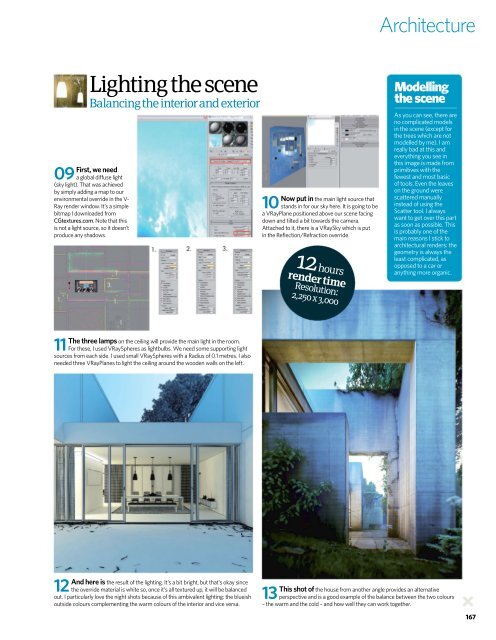Create successful ePaper yourself
Turn your PDF publications into a flip-book with our unique Google optimized e-Paper software.
Architecture<br />
Lighting the scene<br />
Balancing the interior and exterior<br />
First, we need<br />
09 a global diffuse light<br />
(sky light). That was achieved<br />
by simply adding a map to our<br />
environmental override in the V-<br />
Ray render window. It’s a simple<br />
bitmap I downloaded from<br />
CGtextures.com. Note that this<br />
is not a light source, so it doesn’t<br />
produce any shadows.<br />
Now put in the main light source that<br />
10 stands in for our sky here. It is going to be<br />
a VRayPlane positioned above our scene facing<br />
down and tilted a bit towards the camera.<br />
Attached to it, there is a VRaySky which is put<br />
in the Reflection/Refraction override.<br />
12 hours<br />
render time<br />
Resolution:<br />
2,250 x 3,000<br />
Modelling<br />
the scene<br />
As you can see, there are<br />
no complicated models<br />
in the scene (except for<br />
the trees which are not<br />
modelled by me). I am<br />
really bad at this and<br />
everything you see in<br />
this image is made from<br />
primitives with the<br />
fewest and most basic<br />
of tools. Even the leaves<br />
on the ground were<br />
scattered manually<br />
instead of using the<br />
Scatter tool. I always<br />
want to get over this p<strong>art</strong><br />
as soon as possible. This<br />
is probably one of the<br />
main reasons I stick to<br />
architectural renders: the<br />
geometry is always the<br />
least complicated, as<br />
opposed to a car or<br />
anything more organic.<br />
The three lamps on the ceiling will provide the main light in the room.<br />
11 For these, I used VRaySpheres as lightbulbs. We need some supporting light<br />
sources from each side. I used small VRaySpheres with a Radius of 0.1 metres. I also<br />
needed three VRayPlanes to light the ceiling around the wooden walls on the left.<br />
And here is the result of the lighting. It’s a bit bright, but that’s okay since<br />
12 the override material is white so, once it’s all textured up, it will be balanced<br />
out. I p<strong>art</strong>icularly love the night shots because of this ambivalent lighting: the blueish<br />
outside colours complementing the warm colours of the interior and vice versa.<br />
This shot of the house from another angle provides an alternative<br />
13 perspective and is a good example of the balance between the two colours<br />
– the warm and the cold – and how well they can work together.<br />
167


